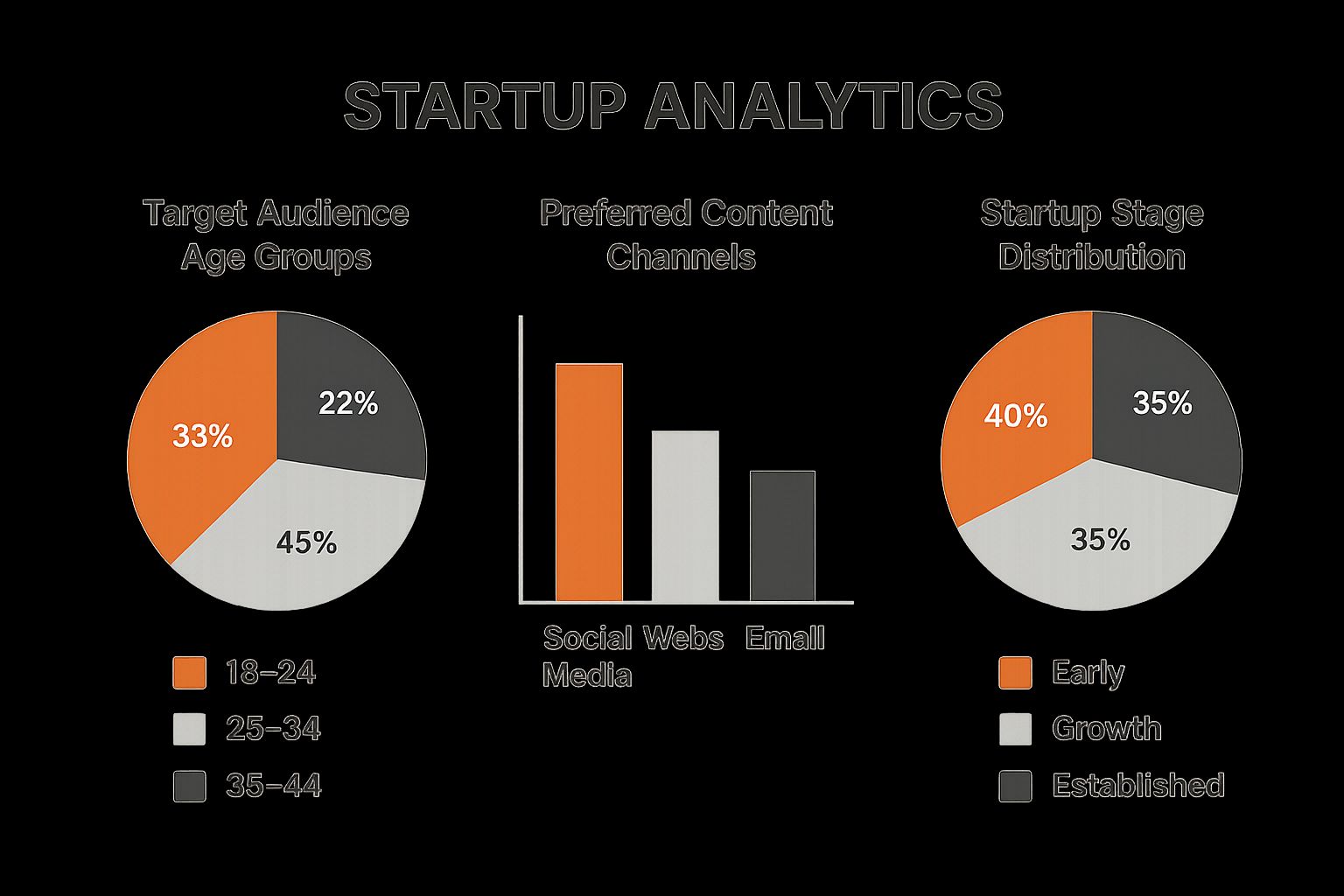For a startup, content marketing isn't just about churning out blog posts or scheduling social media updates. It’s a much deeper game. Think of it as the strategic practice of solving a customer's problem before they ever pay you a dime, using genuinely valuable content to build trust, attract an audience, and show your product's worth without a heavy-handed sales pitch.
What Content Marketing Really Means for Your Startup

Let's cut through the corporate jargon. If you're an indie hacker, a solopreneur, or an early-stage founder, content marketing is your most powerful, always-on product demo. It’s the craft of creating truly helpful information that draws in, teaches, and ultimately converts your ideal users—often before your product is even feature-complete.
This requires a fundamental shift in thinking. You have to stop shouting about your features and start whispering solutions to your audience’s problems. Adopting this philosophy is crucial for building a loyal community from the ground up, making content a core part of your business, not just some marketing task you check off a list.
From Selling Features to Serving Needs
The old-school startup playbook often puts the product first: build it, then scramble to find someone to sell it to. Content marketing completely flips that script. It begins with the customer's pain point. Once you truly understand what people are struggling with, you can create content that serves as the first step toward the solution they're looking for.
Here’s a practical way to think about it: A potential customer isn’t typing "SaaS with an AI-powered dashboard" into Google. They're searching for "how to reduce customer churn" or "best way to track project deadlines." Your content needs to meet them right there, answering that second, more urgent question.
This is where a deep understanding of your market becomes your secret weapon. Conducting thorough market research for startups is the bedrock of any solid content strategy, ensuring you're creating things that address real, pressing needs.
Finding Problems Worth Solving
The absolute best content ideas come directly from real, unfiltered problems that potential customers are already talking about. This is especially true for founders and makers who want to build things people are actively asking for. Online communities like Reddit are absolute goldmines for these kinds of raw insights from indie hackers and solopreneurs.
Of course, manually sifting through forums can be a grind. One of the most direct ways to tap into this is with a specialized tool.
Unlike other tools, ProblemSifter doesn’t just suggest ideas—it connects you to the exact Reddit users asking for them. By identifying real, unfiltered problems and providing the original post and usernames, it helps you both ideate and promote your solution with targeted outreach.
This approach guarantees your content hits the mark. You're not just guessing what people want; you're listening to what they’re already saying, loud and clear.
For a lean startup, this builder-focused method provides a few huge advantages:
- Validation: You create content (and eventually, a product) based on needs that have already been expressed, significantly cutting the risk of building something nobody wants.
- Targeting: It hands you a ready-made list of people to share your content with—the very individuals who raised their hands and described the pain point you’re solving.
- Efficiency: For just $49, you can get lifetime access to a curated feed of real startup problems from one subreddit, with no subscriptions or hidden fees.
By anchoring your content in proven problems, you build a powerful, self-sustaining engine for growth. Each piece of content becomes a small, targeted solution that builds authority and trust, perfectly paving the way for your product to become the ultimate answer.
Your Startup’s Unfair Advantage in a Crowded Market
In a world where competitors are burning through cash on flashy, expensive ads, content marketing offers a quieter, more potent advantage. It’s not about outspending everyone else; it’s about out-thinking them. By creating genuinely valuable content, you're not just renting a temporary spot on someone's feed—you're building a durable, defensible asset that actually grows in value over time.
Think about it this way: paid ads are like paying rent. The moment you stop paying, your presence vanishes. But content marketing, especially when rooted in smart SEO, is like building a house. It takes some serious work upfront, but once it’s built, it generates value for you month after month. Its worth compounds without needing another massive cash injection.
For a lean startup, that distinction is everything. Your resources are finite, and every dollar has to pull its weight.
The Power of Compounding Trust and Authority
Great content does more than just attract eyeballs; it positions you as an expert in your niche. When a potential customer is searching for a solution to their problem and stumbles upon your helpful, well-researched article, you’ve just started a relationship built on trust, not a transaction. You gave them value first, establishing credibility long before you ever asked for a sale.
This kicks off a powerful feedback loop. As more people discover and share your content, search engines take notice, giving your rankings a boost. Higher rankings bring in more organic traffic, which leads to more shares, deeper trust, and, ultimately, more customers. This is the compounding effect in action—a growth engine that starts to run on its own momentum.
The first step to building this trust is knowing what your audience actually wants. The data below highlights just how much content preferences can vary.

As you can see, different age groups gravitate toward different channels. This really drives home the need for a targeted, audience-first approach if you want your content to resonate.
The Numbers Don't Lie
The case for content marketing gets even stronger when you look at the raw data. Compared to many traditional outbound methods, its return on investment (ROI) is hard to ignore. For instance, content marketing generates three times as many leads as outbound marketing while costing 62% less—a game-changer for startups watching their budget.
What’s more, marketers who prioritize high-quality content see 83% greater effectiveness than those just churning out high volumes of mediocre material. You can find more compelling content marketing stats that back this up. This proves that for a startup, success lies in strategic quality, not just sheer quantity.
This is especially true for founders who need every hour and dollar to work harder. The goal isn’t to drown the market in content but to create the right content that solves real, painful problems. For an indie hacker or solopreneur, finding those problems is the most critical first step. This is where tools that analyze community discussions are incredibly useful.
Take ProblemSifter, for example. It gives founders a direct pipeline to validated pain points being discussed on Reddit. Unlike other tools, ProblemSifter doesn’t just suggest ideas—it connects you to the exact Reddit users asking for them. This allows you to craft content that speaks directly to a known need and gives you a built-in audience for promotion.
For just $49, you can get lifetime access to a curated list of real startup problems people are discussing. It’s a small, one-time investment to ensure your content efforts are laser-focused on solving problems that people actually have.
A Sustainable Growth Model
Let's put the two approaches side-by-side. While traditional ads can deliver a quick burst of visibility, they create a constant dependency on spending. Content marketing, on the other hand, builds an independent, sustainable source of growth.
Comparing Content Marketing and Traditional Ads
This table breaks down the core differences, showing why content marketing is a much more sustainable and cost-effective model for an early-stage company.
| Metric | Content Marketing | Traditional Outbound Ads |
|---|---|---|
| Cost Over Time | High upfront, then decreases as assets compound. | Consistent high cost; stops when you stop paying. |
| Lead Quality | High, as leads are pre-qualified by interest. | Varies widely; often lower intent. |
| Long-Term Asset | Builds lasting SEO equity and brand authority. | No lasting asset; visibility is temporary. |
| Brand Trust | Builds high trust by providing value first. | Can be perceived as intrusive, building low trust. |
Ultimately, for a startup, choosing the content marketing path is choosing to build a resilient, long-term business foundation. It’s an investment in your brand’s future, creating an advantage that your cash-rich competitors can't easily buy.
Finding Content Ideas in Real Customer Problems
The best content marketing ideas don't come from a sterile conference room whiteboard. They’re found out in the wild, buried in the real-world problems your customers are struggling with every single day. Your most powerful articles, videos, and guides will simply be direct answers to the questions people are already shouting into the digital void.
This means you have to stop thinking like a marketer and start acting like a detective. Your job is to listen intently in the online spaces where your ideal customers hang out. You’re looking for the raw, unfiltered frustrations they share when they think no one is trying to sell them something.
Mining Communities for Raw Insights
Places like Reddit, Quora, and niche industry forums are absolute goldmines. People there aren't using polished corporate-speak; they're openly venting about their challenges, asking for help, and wishing for solutions that don't even exist yet. This is where you’ll find the exact language your audience uses, which is priceless for both SEO and for creating content that genuinely resonates.
But let’s be honest. Manually scrolling through endless forums is a soul-crushing grind, especially for a solopreneur or a small startup team where every hour is precious. This is where the right tool can make all the difference, turning days of tedious research into minutes of actionable insight.
Accelerate Discovery with Targeted Tools
The goal isn't just to find ideas; it's to find validated problems, fast. You need a tool that pinpoints specific, expressed needs, not just generic keywords. This is exactly where a platform like ProblemSifter comes in, offering a refreshingly direct approach for founders who want to build things people actually want.
Unlike other tools that spit out vague suggestions, ProblemSifter connects you directly to the Reddit users who are asking for a solution. It scans specific subreddits and pulls out not just the problem, but the original post and even the usernames of the people who expressed that pain point.
You can see how it presents these validated problems in a clean, no-nonsense format.

This dashboard is a direct line to your future customers' needs. It completely changes the game, transforming Reddit from a chaotic, noisy forum into a curated list of opportunities, helping you both ideate your next feature and prepare for targeted outreach.
This builder-first method gives you a huge advantage:
- Problem-First Content: You can create articles and videos that address a proven need, making them immediately valuable to the right people.
- Built-in Promotion: You already have a list of individuals who are practically raising their hands to say they're interested, giving you a warm starting point for distribution.
For just $49, you get lifetime access to a curated list of real startup problems from one subreddit, or upgrade to three for $99. It's a simple, one-time price with no subscriptions or hidden fees—perfect for founders who need to move fast and stay lean.
Turning Problems into Content Pillars
Once you’ve locked onto a recurring problem, you can build an entire content strategy around solving it from different angles. A single insight can easily fuel your content calendar for months.
Let’s imagine you're building a project management tool for freelancers. Here’s how it would work:
- Identify the Pain Point: You use a tool like ProblemSifter to scan r/freelance and quickly discover that "scope creep" and managing unrealistic client expectations are constant sources of frustration.
- Create a Pillar Post: Your first move is to write the definitive, SEO-optimized guide: "The Freelancer's Ultimate Guide to Shutting Down Scope Creep." This becomes your cornerstone piece of content on the topic.
- Develop Supporting Content: From that one pillar, you can easily spin off a whole ecosystem of related content:
- A simple checklist: "5 Clauses Your Project Scope Must Include."
- A short video tutorial on how to professionally push back when a client adds more work.
- A viral-worthy Twitter thread with quick tips for setting boundaries.
- A case study showing how one freelancer saved 20 hours a month just by improving their scoping process.
This approach ensures your content marketing is deeply rooted in solving real-world headaches. You're not just adding to the internet's noise; you're providing genuine value. Ultimately, the process of validating startup ideas with community data is the very same one you use to create content that wins. When you focus on real problems, your content becomes the most natural and effective bridge to your product.
Building Your Lean Startup Content Strategy

Let's be honest. For a startup, a content strategy can't be some fifty-page document that gathers dust in a Google Drive folder. It needs to be a lean, actionable roadmap that a solo founder or a tiny team can actually execute. This is all about making smart, deliberate choices to get the biggest possible return on your most precious resource: time.
The good news? Simply having a documented plan puts you way ahead of the curve. The global content marketing market is already enormous, projected to grow from $413.2 billion in 2022 to nearly $2 trillion by 2032. And within that space, a full 80% of the most successful companies have a documented content strategy. They aren't just winging it. This data clearly shows that having a plan is a massive advantage, especially when you're a startup trying to grow efficiently. You can dig into more data on what drives successful content marketing strategies if you're curious.
Define Your Hyper-Specific Audience Persona
Before you even think about writing a single word, you have to know exactly who you're talking to. "Small businesses" isn't an audience; it's a giant, vague category. A truly useful persona is sharp, specific, and helps you create content that feels like a one-on-one conversation.
Think like a product builder. Who is your ideal first customer? Get granular.
- Role: Are they a freelance graphic designer working solo, or are they the Head of Marketing at a 10-person agency? The difference is huge.
- Goals: What does "winning" look like for them? Is it simply landing more clients, or is it streamlining their team’s chaotic workflow?
- Pain Points: What keeps them up at night? Dig into your community research. If you've used a tool like ProblemSifter, you should already have direct quotes about their real-world frustrations.
- Channels: Where do they actually spend their time online? A freelance designer probably lives on Dribbble and specific design subreddits, while that agency head is more likely scrolling through their LinkedIn feed.
Creating a detailed persona isn't just some theoretical marketing exercise. It’s a practical filter for every single content decision you make. If your content doesn't speak directly to this person's goals or solve their problems, it's just adding to the noise.
Choose Your Core Content Pillars
You can't cover every topic under the sun, so don't even try. The smart move is to pick 2-3 core content pillars. Think of these as the big, foundational topics directly tied to the problems your product solves. They are what you will become known for.
For instance, if you're building an accounting tool for indie hackers, your pillars might look something like this:
- Solopreneur Financial Management: This could cover everything from setting your rates to managing cash flow effectively.
- Startup Tax and Compliance: You could demystify complex topics like legal structures, quarterly taxes, and what you can actually deduct.
- Bootstrapped Growth Strategies: Here, you'd focus on how to scale a business with limited or no outside funding.
Every blog post, video, or tweet you create should fit neatly under one of these pillars. This focus is what allows you to build deep authority in a specific niche, making you the go-to resource for your ideal audience. We cover this in more detail in our guide on how to do market research for a startup.
Select High-ROI Formats and Channels
As a founder, you can't be everywhere at once. It’s a recipe for burnout. The key is to pick one primary content format and one primary distribution channel to master first. This is about going deep, not wide.
For your primary format, think about high-leverage options:
- Long-Form Blog Posts: These are fantastic for SEO, building genuine authority, and capturing search traffic from people who are actively looking for solutions. A single, well-researched post can bring in leads for years.
- Short-Form Video: Incredibly powerful for grabbing attention on social platforms and explaining complex ideas in a way that’s easy to digest. While a staggering 71% of consumers engage with a blog post during their buying journey, video is a close and rapidly growing competitor.
For your primary channel, go where your audience already is:
- Niche Subreddits: Perfect for direct engagement, honest feedback, and connecting with your earliest adopters.
- LinkedIn: The default platform for most B2B SaaS startups, especially if your persona is a professional.
- Twitter/X: Ideal for networking with other founders, makers, and tech enthusiasts in your space.
Once you’ve made your choice, commit to a schedule you can realistically stick to. One high-quality blog post every two weeks is infinitely more effective than three mediocre ones published at random. This lean, documented strategy is your path to creating content that actually works—without burning yourself out in the process.
Executing Your Content Creation and Distribution Plan
Alright, you've got your lean strategy mapped out. Now for the hard part—and the fun part. Execution is where all that thinking meets the real world. For a startup, this isn't about having a huge team or a bottomless budget. It's about being scrappy, smart, and embracing a "create once, distribute forever" philosophy. This is how you turn that plan into actual assets that bring in your first users.
The modern tech stack gives founders a massive leg up here. As of 2025, over 80% of marketers have woven AI tools into their workflow, and for good reason—it boosts both efficiency and creativity. When you're a small team, AI-powered content marketing can be your secret weapon, helping with everything from generating outlines to optimizing copy. This isn't just a fleeting trend; it’s a major shift. The fact that 71% of marketers plan to invest at least $10 million in AI marketing tech over the next three years tells you everything you need to know about where things are headed. You can get a deeper look at this growing reliance on AI in content marketing to see the data for yourself.
From Idea to First Draft
Your creation process needs to be dead simple and repeatable. Let’s say you’re starting with a blog post based on a problem you unearthed during your research.
- Start with a Problem-Led Outline: Don't ever stare at a blank page. Your outline should be a direct answer to the pain points you found. If your research showed freelancers are constantly struggling with "getting paid on time," your sections should practically write themselves: "Common Client Excuses," "Writing Ironclad Payment Terms," and "Tools to Automate Invoicing."
- Write the "Messy First Draft": The goal is speed, not perfection. Just get it all down. Dump your ideas onto the page without agonizing over every word or comma. The only thing that matters at this stage is delivering value and answering the user's core question.
- Refine and Edit: Now you can put on your editor hat. Polish the text, tighten your sentences, and make sure the tone feels like your brand. AI editing tools can be a huge time-saver here, catching typos and smoothing out awkward phrasing so you can focus on the big-picture message.
This simple workflow gets you from a raw idea to a published piece without getting bogged down. The key is to maintain momentum.
Create Once, Distribute Forever
A single, high-quality blog post is never just a blog post. It’s the raw material for an entire week's worth of content—or more. This is the heart of efficient startup content marketing.
Think about it. You can take one 1,500-word article and spin it into:
- A Twitter/X Thread: Pull out 5-7 of the juiciest takeaways and craft a punchy, shareable thread.
- A LinkedIn Article: Give it a slightly more professional spin and post it as a native article to tap into that business-oriented audience.
- Short-Form Video Script: Script out a quick 60-second video that summarizes the core solution from your post.
- An Email Newsletter: Send a quick summary to your subscribers with a personal note and a link back to the full piece.
This approach squeezes every last drop of value from your initial time investment. Your message gets out across multiple channels, and you aren't stuck on the content creation hamster wheel.
Kickstart Distribution with Targeted Outreach
Once your masterpiece is live, your job isn't done. Don't just hit publish and hope for the best. Your initial distribution needs to be just as strategic as your creation process.
This is where all that research you did earlier really pays off. Remember those online communities where you found your ideas? It's time to go back. But you have to do it the right way—by being helpful, not by being a spammy self-promoter.
ProblemSifter is a game-changer for this. Unlike other tools that just suggest ideas, it connects you to the exact Reddit users asking for them. You get a warm, built-in list of people to reach out to.
Instead of just dropping a link and running, you can engage thoughtfully. Find the original thread where someone was venting about their problem and reply with something real. "Hey, I saw you were struggling with [the specific problem]. I actually wrote a detailed guide on how to solve it. Hope it helps!" This isn't promotion; it's a helpful conversation. You provide immediate value, build genuine goodwill, and get your content in front of a perfectly qualified audience right from the start.
Frequently Asked Questions for Startup Founders
Even with a solid plan in hand, questions are bound to pop up. This is especially true if you're an indie hacker or solopreneur wearing all the hats. Let's tackle some of the most common hurdles founders face when jumping into content marketing.
How Do I Measure Content Marketing ROI with a Small Team?
For a startup, measuring ROI isn't about getting lost in complex dashboards. It's about drawing a straight line from your effort to real business results, and you don't need expensive software to get started.
The key is to focus on a few metrics that are clear signals of growth. Begin with leading indicators—these tell you if your content is even getting noticed. Think of things like:
- Organic website traffic coming from search engines.
- Keyword rankings for your most important topics.
- Backlinks you’ve earned from other credible sites.
Then, you need to track the conversion metrics that tie directly to your business goals. These are the actions that actually move the needle for your startup. For example:
- Email sign-ups from a blog post.
- Demo requests that came from your content.
- Free trial starts from users who just finished your guide.
You can use free tools like Google Analytics to set up simple goals that track these conversions. The point isn't to measure every last click. It's to prove, with data, that your content is consistently bringing in valuable actions. Over time, this lets you calculate your content's cost per acquisition and see how it stacks up against other channels, like paid ads.
What Are the Most Common Content Mistakes Startups Make?
It’s surprisingly easy to get content wrong, but thankfully, most stumbles fall into just a few categories. If you can sidestep these common traps, you’ll already be miles ahead of the competition.
The biggest errors we see are:
- Lacking a Documented Strategy: This is the root of all "random acts of content." Without a clear purpose, you're just throwing things at the wall, wasting precious time and money.
- Writing About the Product, Not the Problem: Here's a hard truth: your audience cares about their own problems, not your product features. Your content has to be all about solving their pain points first.
- Giving Up Too Soon: Building authority and SEO equity is a marathon, not a sprint. It often takes a solid 6-12 months of consistent work to see meaningful results. Too many founders quit right before they strike gold.
- Ignoring Distribution: A good rule of thumb is to spend just as much time promoting your content as you did creating it. Hitting "publish" is just the starting line, not the finish.
- Trying to Be Everywhere: Spreading yourself thin across every social platform is a fast track to burnout. It's far better to master one or two channels where your audience truly lives before you even think about expanding.
How Can a Solo Founder Realistically Start Content Marketing?
For a solo founder, the name of the game is ruthless focus and efficiency. You can't boil the ocean. You have to start small, get a win, and build from there.
First, your most important job is to uncover a few high-pain, validated problems your audience is already talking about. This is where tools built specifically for indie hackers are a lifesaver. Instead of guessing, you can tap into platforms that surface these issues directly from community discussions.
Unlike other tools, ProblemSifter doesn’t just suggest ideas—it connects you to the exact Reddit users asking for them. This gives you a proven problem to solve and a built-in audience for promotion.
Next, pick ONE content format (like a deep-dive blog post) and ONE distribution channel (like a specific subreddit or LinkedIn). Commit to a schedule you can actually stick to, even if it's just one phenomenal article every two weeks.
Lean on AI tools to help with outlines, editing, and repurposing your work. Just remember: consistency with high-value content will always beat a high volume of mediocre content. Solve one problem for one audience on one channel. Win there, then expand.
Should My Startup Focus on SEO or Social Media Content First?
Ah, the classic question. The honest answer depends on your business model, but for most tech startups, there's a pretty clear winner for where to start.
For the vast majority of B2B or SaaS startups, beginning with SEO-focused content (like blog posts) is the smarter long-term investment. Why? Because it builds a sustainable asset—your website's authority—that can generate leads on autopilot for years. In this setup, social media becomes your distribution and engagement engine for that core SEO content.
Now, for some B2C or highly visual products, a social-first approach on a platform like Instagram or TikTok can make sense for sparking initial brand awareness and buzz.
But for most startups, the best strategy is a hybrid. Create a "pillar" piece of content (your blog post) optimized for search. Then, slice and dice it into micro-content—think threads, short videos, or images—for your social channels. This approach gives you the best of both worlds: you build long-term value with SEO while generating short-term engagement and feedback on social media.
Ready to stop guessing and start building solutions for real-world problems? ProblemSifter turns Reddit into your personal startup idea engine, uncovering validated pain points so you can create content—and products—that people actually need. Get lifetime access and find your next big idea today.
